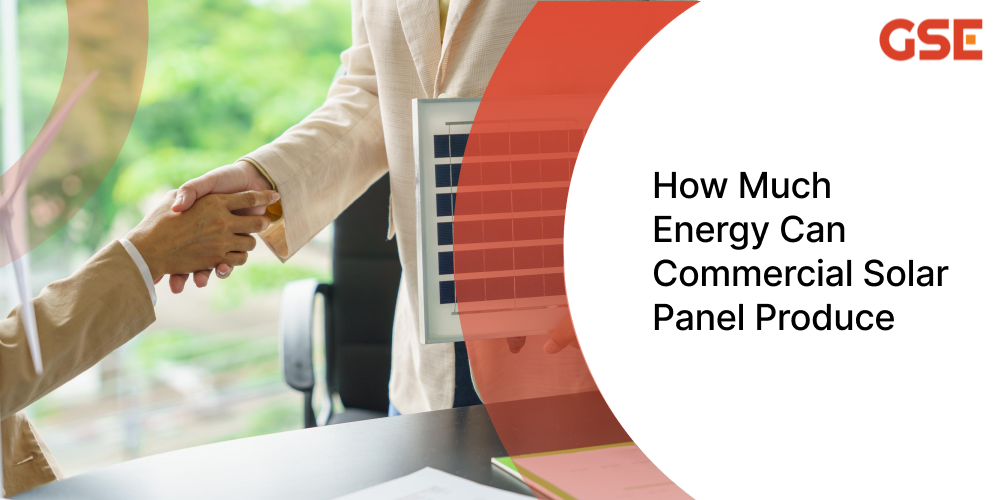500 kW Solar Power Plant Cost in Gujarat: Complete Price & Savings Guide
Nov 26

As more businesses turn to solar power, it’s important to know how much energy commercial solar panels can produce. This helps you figure out how many panels you need and which type is best for your business.
Solar panels for businesses are becoming increasingly popular due to their potential to significantly reduce energy costs and carbon footprints. Solar PV systems offer electricity at around 4-5 pence per kWh, compared to the current grid rate of approximately 15-16 pence per unit. This financial advantage makes solar power a compelling choice for many businesses.
To determine how much energy a commercial solar power system can generate, a solar PV system designer uses specialized software. This software analyzes historical solar irradiation data, typically from the past 10-15 years, and considers factors such as roof pitch, orientation, and the specific panels and inverters used. The result is a detailed projection of the system’s annual energy output. Before installing solar panels for business, evaluate your energy needs and the potential savings. A well-designed commercial solar power system can provide substantial benefits, both financially and environmentally, making it a valuable investment for many organizations.
Understanding how much energy your commercial solar power system can generate is essential for making an informed decision. With the right system in place, you can harness the power of solar energy to benefit your business and contribute to a more sustainable future.
Commercial solar panels are designed for larger installations and offer higher energy output compared to domestic panels. At GSE Renewables, we provide tailored solutions for commercial solar PV panels, ensuring optimal performance for various business needs. Our expertise extends to installing and maintaining commercial solar power panels that are customized to your building’s specifications.
We specialize in comprehensive commercial solar systems that include everything from initial setup to ongoing maintenance. Our services also cover solar power for commercial applications, including pest protection and upgrades to existing commercial solar power systems. With GSE Renewables, you get a complete solution for harnessing solar energy efficiently and effectively.
Read More: Commercial Solar System Installation Process
The efficiency of a commercial solar system can be influenced by several key factors:
Understanding these factors helps in maximizing the performance of your commercial solar power panels and ensures that your solar power system for business operates efficiently.
Read More – How Does Commercial Solar Panel Work?
The power output of a solar panel is typically measured in Watts (W) or Kilowatts (kW), where 1kW equals 1,000 watts. This rating indicates the maximum power output the panel can produce under ideal conditions, usually measured under standard test conditions (STC) of 1000
To estimate how much energy a commercial solar panel system can generate, use the following formula:
Energy Output (kWh) = Number of Panels × Panel Rating (kW) × Sunlight Hours per Day
For example, let’s calculate the energy output for a commercial solar installation with 100 panels, each rated at 400 watts (0.4 kW), in an area with an average of 5 sunlight hours per day:
Energy Output = 100 Panels × 0.4 kW × 5 Hours = 200 kWh per Day
This means the system can produce 200 kilowatt-hours of energy daily under these conditions
As technology improves, commercial solar power panels are becoming more efficient and effective. Here are some key trends to watch:
These trends will enhance how solar panels for businesses generate and use renewable energy, helping businesses achieve their sustainability goals.
Commercial solar panels offer businesses the opportunity to generate significant amounts of energy, leading to considerable financial savings and a reduced environmental impact. By recognizing the key factors that affect solar energy production and fine-tuning their solar setups, companies can maximize the benefits of this renewable resource. As technology improves and costs decrease, the adoption of commercial solar panels is set to grow rapidly, driving a shift towards a more sustainable and eco-friendly future.
The power rating of a commercial solar panel typically ranges from 250W to 500W. Higher ratings, such as 400W to 500W, are common in larger commercial installations.
The energy production of a commercial solar panel varies, but a typical panel can generate between 300 to 500 watts (0.3 to 0.5 kW). Over a day, this translates to approximately 1.5 to 2.5 kWh, depending on sunlight conditions and panel efficiency.
The average output of a commercial solar panel typically ranges from 250 watts to 500 watts, depending on its size and efficiency.
Commercial solar panels typically have an efficiency of 15% to 22%, indicating how much sunlight they convert into electricity.
